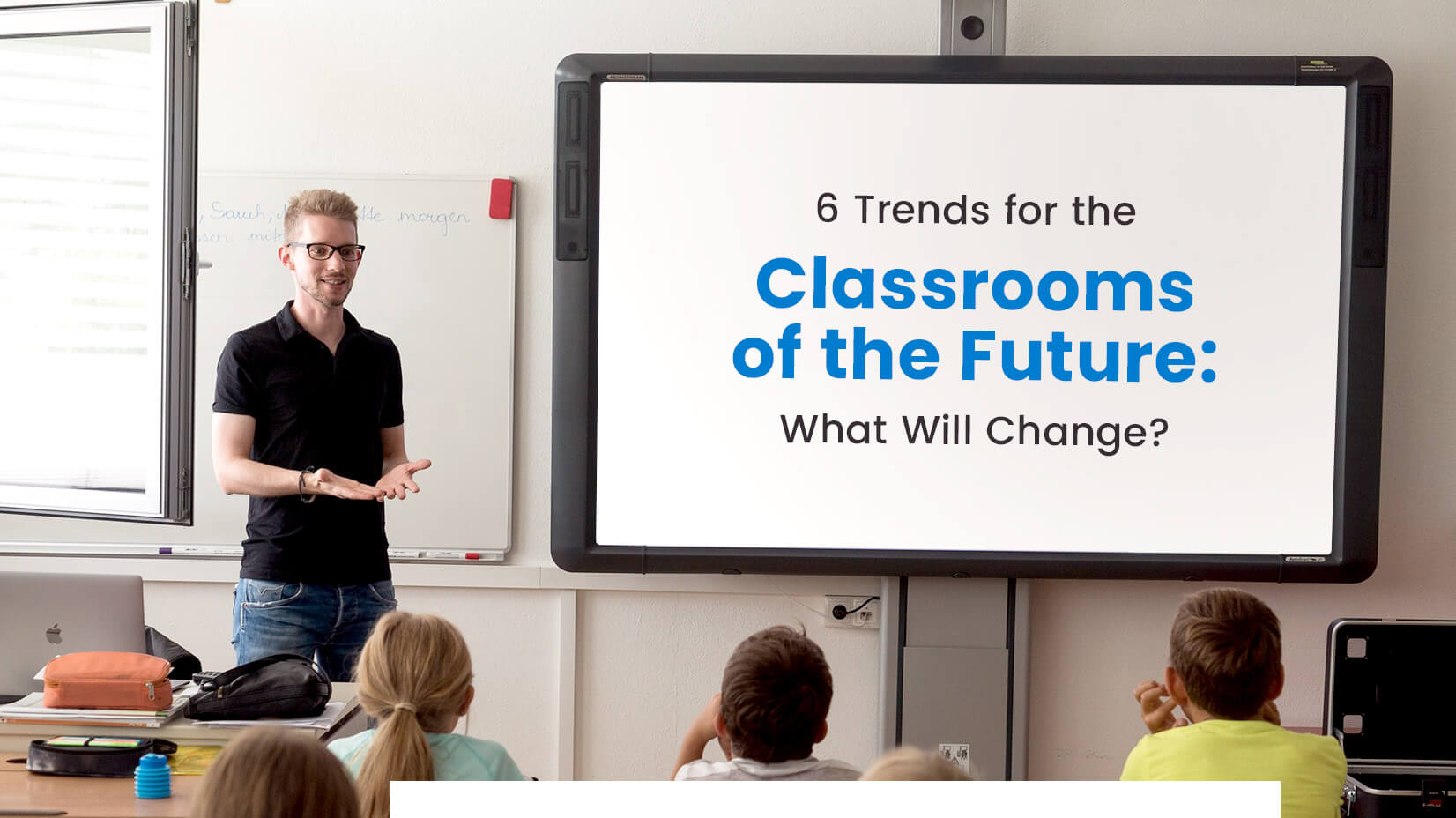
In the 21st century, technology is taking over the classrooms of the future in more than one way. And this isn’t surprising. When we talk about a technology-driven generation of kids, the whole education system has to evolve and adapt in order to be efficient.
The technology-based classrooms of the future are no longer a concept of the future. The changes in the way of teaching kids are already happening. Students and teachers have started using cloud spaces to store work, post grades and assignments. They are using online portals to complete tests online and collaborative tools to work on team projects. What is about to happen next to the classrooms and the teaching methods? Let’s find out.
Flexible classroom arrangements
The classroom of the future will become more flexible in order to correspond to the individual needs of students and the needs of class activities.
Schools are expected to become more welcoming, so students can feel more comfortable in the buildings and classrooms. Some of the expected measures are to make schools greener, introduce moving walls that make rooms adaptable and more. These are just the first steps to support a more effective learning process.
In terms of classroom arrangements, the positions of the desks will be no longer fixed. On the contrary, they will be adaptable to the needs of students and class activities. There will be more opportunities to rearrange classrooms in order to achieve better collaboration and interaction between the students and the teacher. It’s highly likely that students will be given more freedom of where to sit, so that they can feel more comfortable in class.

Image source: Pixabay
Standing desks will also make it into the classrooms of the future to meet the needs of children who have trouble focusing while sitting. Private workstations and study pots will help student focus while working on individual projects, and collaborative workspaces will boost the effectiveness of teamwork. In addition, the windows of the school buildings may be replaced with ones that decrease glare on device screens in order to prevent eye damage.
These are just some of the measures planned to optimize the school buildings, all in favor of achieving a more effective learning process. Moreover, some schools may provide accommodation for those students who need to travel.
The classrooms of the future are technology friendly
As technology becomes more and more involved in education, it will invade the classrooms to such an extent that the whole learning process will become dependant on it.
It is expected that interactive whiteboards will replace the traditional whiteboards for several reasons. The innovative technology, which is also called a smart board, allows teachers to use pictures, videos, graphs and other graphic material that enriches and simplifies the whole teaching process. In result, the students’ engagement will increase.
If you are interested in smart boards, you can find graphics for your ideas in this article: Free Clipart For Teachers: Top 12 Sources To Find What You Need.

Image source: Pixabay
Interactive whiteboards are a perfect solution for group interaction and collaboration. By acting as a shared resource, interactive whiteboards allow students to participate in the board activity from their own seats and their own devices. Of course, the classrooms of the future will be equipped with enough charging ports, so that students will be able to charge their devices. Interactive whiteboards encourage the use of different learning styles and they have even more benefits such as recording the lessons, so students can have access to them later.
Tablets and eBooks on each desk instead of textbooks and notebooks will become a common view in the classrooms of the future. Effortless internet connectivity is a must-have prerequisite for a seamless technology-based education. The classrooms of the future should provide strong Wi-Fi connections, so the teaching process can be efficient. Of course, all of this would not be possible without reliable cybersecurity and control of access.

Image source: Pixabay
Simulation technologies enter the classrooms of the future
Virtual reality and augmented reality technologies are inevitably part of the future of web design. Very soon, they will enter the classrooms, as well.
It is expected that simulation technology will help create various learning styles. Augmented and virtual learning will improve the whole learning process by creating experiences that a text-based book simply can’t provide. Simulation technologies will allow students to visit places virtually, experience three-dimensional demonstrations and more.

Image source: Pixabay
Virtual reality and augmented reality technologies can trigger all senses by using 3D images, video, sound, and interaction. This way, they will help students accept information much more effectively than traditional methods. Plus, they really help students to engage with the material.
The good news is, VR and AR glasses don’t have to be made of high-cost materials. The simulation technology headsets can be made of low-cost cardboard so that they can be affordable to more schools.

Image source: Pixabay
To get interesting insight on how children learn, check out this article – Visuals for Kids: Enhancing Communication and Learning
An online classroom: from concept to reality
While VR and AR technologies haven’t become mass in classrooms yet, the concept of an online classroom has started to become more clear and achievable for more and more schools.
Teachers and educators have started taking full advantage of the internet and all the benefits that come with it, be it online assignments and assessment, storage of students’ work on the cloud, online collaborative work and more online activities that make the learning process easier.
Remote access software, screen sharing technologies, as well as online tools, apps, and platforms developed specifically for educational purposes, make the concept of a virtual classroom possible. In a virtual classroom, students can participate in group activities no matter their locations. Even more, such a digital environment makes communication between students, teachers, and parents easier.

Image source: Pixabay
Online classrooms are a breath of fresh air for both students and teachers. On the one hand, online classrooms are perceived as more exciting and fun by the students. In result, their engagement is boosted. On the other hand, the online teaching environment provides teachers with creative teaching approaches and assessment tools that save time and effort.
The online assessment software will become more and more advanced. It is expected that it will go beyond the grammar and plagiarism check. The innovative assessment software, which is about to enter the classrooms of the future, will be able to perform a full check on students’ writing work in terms of the vocabulary used and relevance to the topic and even create a list of revisions. Moreover, when it comes to online testing programs, innovative software will be able to identify the weak areas for each individual student. This way, the teachers will be able to create a more effective individual approach for each student and conduct individualized tasks and assessments.
Do you want to check out The Best Online Learning Platforms in 2022?
Games and apps actively involved in education
The concept of introducing and using video games for educational purposes is called gamification. It is believed that using video games to teach children will help them engage with the material better. There are already several developers creating games for the classrooms in the field of mathematics, science, English language arts and more. The idea is to make students more comfortable and inclined to learn geometry, algebra and other subjects. The games which are already available for use, provide practical experiences and a fun way to gain new knowledge.

Image source: Pixabay
In addition to video games, there are more and more education-related apps that will help teachers be flexible and innovative in their teaching methods. The idea behind using apps for education is quite clear. As technology enters the classrooms of the future, the need for using apps for teaching purposes will also increase. Apps for education are already actively developed and they will be used in all fields of science. Education-related apps are not only meant for online classrooms and students’ mobile devices but for augmented and virtual learning technologies, as well.
Revolution of learning: styles, opportunities, technology
Speaking of individualized teaching approaches, we can say that a revolution of learning is coming. As the world evolves, the teaching methods need to evolve, as well. The new generations need new methods of teaching. This means that the one-size-fits-all method will soon become a thing of the past.
The education of the new generation will be marked by multiple learning styles, flexible learning opportunities, and adaptive learning technology. The classrooms of the future will need teachers of the future who will be ready to adapt to the new flexible learning methods.

Image source: Pixabay
As teachers acquire new innovative methods of teaching, students will gain new flexible options to learn. Not only new alternative methods of teaching will be introduced in the classroom but also individualized teaching styles according to each student.
Now, more than ever, students have the opportunity to gain knowledge and develop their skills, for example by enrolling to free online courses in a particular field of interest. In the future, it’s expected that the education system will move its focus to the specific strengths, interests, and goals of each individual student. Schools will encourage their students to follow individual educational paths by building relations with other educational institutions, providing flexible schedules and specific learning environment for their students.
To wrap up,
The classrooms of the future will open doors for more flexible teaching and effective education. All trends in education speak of a better adaptation to the needs of students, as well as better learning and more opportunities for the young generation.
In fact, the classrooms of the future can start happening right here, right now. Ask your students for ideas on how to improve the learning process. You might be surprised by their creativity and ingeniosity.
Have anything to add to this topic? We’d love to see your opinion in the comments below.
Check out GraphicMama’s
Free Educational Presentation Templates for Online Lessons
20 Free educational presentation templates in 2 color schemes, that are compatible with PowerPoint and Google Slides. Perfect for online lessons and home-school presentations.












![How to Use Seamless Patterns in Your Designs [Tips and Tricks]](https://i.graphicmama.com/blog/wp-content/uploads/2020/07/14125818/How-to-Use-Seamless-Patterns-in-Your-Designs-Tips-and-Tricks.png)
